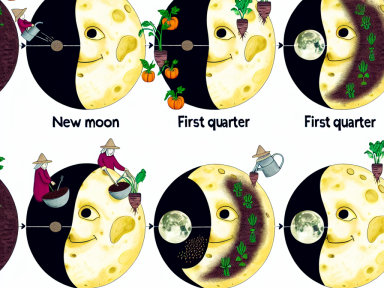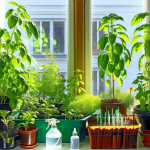The Role of Moon Phases in Gardening
The moon has been guiding human activities for millennia, and gardening is no exception. Understanding the moon’s phases can enhance your garden’s productivity, as the gravitational pull can influence seed germination, plant growth, and water retention. Here’s how to apply lunar wisdom to your planting.
New Moon
During the **New Moon**, gravitational forces pull water upwards, leading to increased soil moisture. This period is perfect for sowing seeds that grow above ground, as the seeds will absorb more water, speeding up germination.
- Plant leafy greens like lettuce, spinach, and cabbage.
- Sow cereal grains such as wheat and barley.
First Quarter (Waxing Crescent)
As the moon shifts to its **First Quarter**, the moisture levels are still high, and the light is increasing, promoting balanced root and leaf growth. It’s an excellent time for planting vegetables that produce seeds outside of the fruit.
- Plant annuals such as tomatoes, pumpkins, and beans.
- Sow flowers like marigolds and petunias.
Full Moon
The **Full Moon** phase exerts strong gravitational forces, drawing up ample amounts of water from the soil. While planting is not recommended, it’s the ideal time for harvesting and maintenance.
- Harvest root crops like carrots, beets, and potatoes.
- Engage in weeding, pruning, and composting activities to maintain garden health.
Last Quarter (Waning Crescent)
During the **Last Quarter**, moisture levels start to decrease. This phase is optimal for planting root crops and bulbs, as the energy of the moon moves back into the roots.
- Plant root vegetables like carrots, radishes, and turnips.
- Sow leguminous plants such as peas and beans.
Lunar Gardening Tips
1. **Observe Local Climate:** While moon phases are influential, local climate conditions are crucial. Ensure the temperature and frost dates align with your planting schedule.
2. **Plan Maintenance:** Use the Full Moon for garden chores like weeding and pest control since plants and pests are weaker.
3. **Experiment & Record:** Keep a gardening journal to note down the success of your lunar planting. This will help you fine-tune your approach over time.
By aligning your gardening activities with the moon’s cycles, you can harness natural forces to boost your garden’s health and productivity. This ancient practice brings harmony between nature and agriculture, nurturing both your plants and your gardening spirit.



GIPHY App Key not set. Please check settings